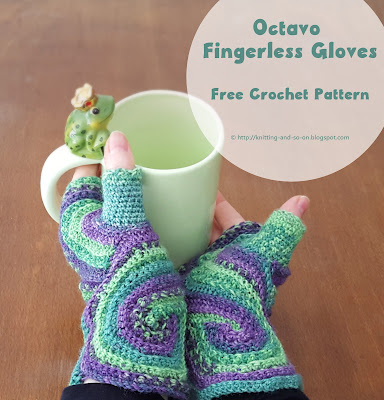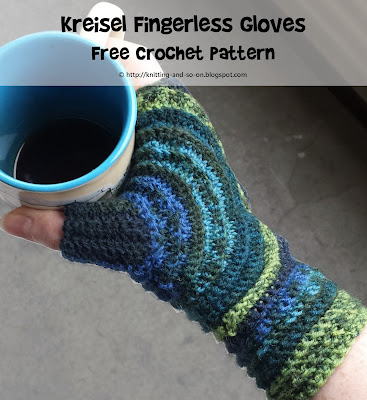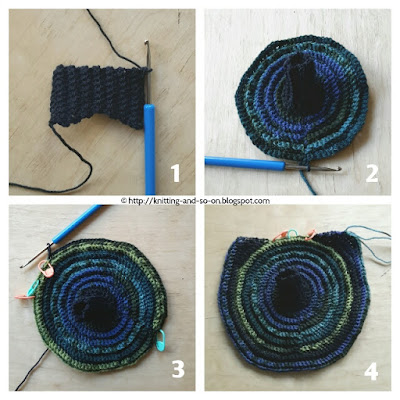These mitts are called Octavo because of the eight-shape (octavo meaning one eighth in Spanish), because they are the crochet version of my Pieces of Eight mitts that I published nearly two years ago (both Pieces of Eight and referring to coins) and - last but not least, because I like the name since the Octavo as a grimoire also plays a role in the library of Unseen University on Terry Pratchett's Discworld.


This work by Knitting and so on is licensed under a Creative Commons Attribution-NonCommercial-ShareAlike 4.0 International License.
An Italian version of this pattern is available here.
Materials
- about 40 to 45 grams of fingering weight yarn
- a 3mm crochet hook
- 4 removable stitch markers
- a tapestry needle to weave in ends
- ch: chain
- sc: single crochet
- sctbl: single crochet through back loop: http://crochet.about.com/od/crochetterms/tp/back-loops-only-or-blo.htm
- sl st: slip stitch: http://www.dummies.com/how-to/content/how-to-crochet-the-slip-stitch.html
- inc: increase by working 2 single crochet stitches into 1 sc below (in case of part 2 of this pattern, it's 2 sctbl into the sctbl below): http://www.dummies.com/how-to/content/how-to-increase-with-single-crochet.html
- dec or sctog: decrease by working 2 single crochet stitches together (in case of this pattern all dec sts are crocheted through the back loop of the 2 underlying stitches: http://www.dummies.com/how-to/content/how-to-decrease-single-crochet.html
- join: joining pieces with crochet: in order to join to pieces (or, in case of this pattern, the two sides of one piece) hold the pieces together with wrong sides facing and insert the crochet hook into both pieces at the same time, a foto tutorial can be found here (scroll down to “Joining with Crochet” http://knitty.com/ISSUEwinter08/FEATwin08TT.php)
- [y]*x: work the sequence y (within the brackets) x times.
- [y] until / to x: work the sequence y (within the brackets) until the condition or point x is met.
- crochet short rows (as done in this pattern (*)): work sc's (or sctbl's) up to the stitch indicated, then turn work (without a turning-chain) and start into the 2nd sc; when you're working over this turn in a following row, always crochet into the turning-sc as well.(*) there may be different methods out there, feel free to try them.
- Foundation Chain: This YouTube-video by the Crochet Crowd explains how to do a foundation chain.
Size and Possible Adjustments
The finished mitts are about 18 cm high and between 19 cm (at the widest point) and 16 cm in circumference.
- The width of the circumference is easily changed by crocheting a few rows more or less in part 3.
- If the thumb is too small for you, you can
a) crochet it with a bigger crochet hook and change back to a 3mm hook when starting part 2,
b) make it a few stitches wider but then adjust the number of increases in row 1 on part 2 that you end up with 31 stitches or
c) do a thumb construction as explained in the Kreisel Fingerless Gloves and pick up 24 sts around it (or adjust the number of increases in row 1 on part 2 that you end up with 31 stitches).
General Construction

These fingerless gloves are worked in three parts as shown in the picture on the right hand side.
Part 1 (the thumb) is crocheted in the round. Then a longer chain is added to prepare for the eight-shape crocheted in part 2 - during this part increases are made around the thumb and decreases are made with the newly chained stitches. This part is crocheted back and forth.
During part 3 the part that covers the back of your hands is done - also back and forth. In the end, the upper edge of this part is connected to the other side of the glove.
Instructions
The pattern starts with a foundation chain because it’s stretchier than a normal crochet chain – alternatively you can start with a normal chain and a bigger hook just for the chain row.
Part 1: Thumb
Do 14 foundation chain sts and join in round with slip stitch
Round 1: sc all stitches - then go on (as in amigurumi – no connections with slip stitch etc.)
Repeat this round 5 more times
R6: sc 4, inc, sc 4, inc, sc4
R7 : sc all stitches
R8 : sc 2, inc, sc 10, inc, sc 2
R9 : sc all stitches
R10 : [sc, inc, sc] 6 times
Close with slip stitch and place a marker in this slip stitch (this marker will be called Middle Marker or MM for short - and it should always be put in the current row)
 Part 2: Eight-Shape
Part 2: Eight-ShapeChain 70 + 1 turning chain and place markers in the 30th and 52nd chain. (These markers can stay there until the end of part 2, i.e. don’t move them up your rows, but just leave them where they are – they will not be used in part 2) - your piece should now look similar to the one in picture 1.
NOTE 1: all increase and decrease stitches in this part are crocheted through the back loop of the underlying stitch only.
NOTE 2: Please note that the sequences in brackets don't always match the number of stitches left (e.g. it might say [dec, sctbl 5], but there are only 4 stitches left) - that's OK. Just continue with the sequence and stop when you run out of stitches (in case of the example above, just make one decrease and sctbl the 3 stitches to the end)
R1: [sc5, dec, sc 5] until you reach MM. For the 1st mitt go on crocheting while looking at the inside of the thumb, for the second mitt go on looking at the outside of the thumb - that way you set up one mitt mirror-inverted to the other). [sc2, inc]*7 times, sc to the end. Now make a slip stitch into the underside of the first stitch of the chain of the last row, and then another slip stitch in the underside of the next chain (see picture 3). Start the next row into the last sc.
R2: [sctbl 1, inc, sctbl 3] to MM, [sctbl 8, dec, sctbl 1] to end, 1 turning-chain
R3: [sctbl 3, dec, sctbl 5] to MM, [sctbl 3, inc, sctbl 2] to the end, connect with 2 sl st into the underside of the 2 next chains stitches and start the next row into the last sc (this is how you'll end all odd-numbered rows in this part - it will be referred to as "connect with 2 sl st")
R4: [sctbl 2, inc, sctbl 4] to MM, [dec, sctbl 7] to end, sctbl to end, 1 turning-chain
Now your piece should look similar to the one in picture 2.
R5: [sctbl 1, dec, sctbl 5] to MM, sctbl 2, [sctbl 3, inc, sctbl 4] to end, connect with 2 sl st
R6: [sctbl 8, inc] to 2 sts before to MM, sctbl 4, [dec, sctbl 5] to end, 1 turning-chain
R7: [sctbl 3, dec, sctbl 1] to 2 sts before MM, sctbl 4, [sctbl 9, inc] to end, connect with 2 sl st
R8: [sctbl 10, inc] to 3 sts before MM. sctbl 6, [sctbl 3, dec] to end, 1 turning-chain
R9: [sctbl 2, dec] to 3 sts before MM, sctbl 6, [sctbl 6, inc, sctbl 5] to end, connect with 2 sl st
R10: [sctbl 7, inc, sctbl 5] to 3 sts before MM, sctbl 6, [dec, sctbl 1] to end, 1 turning-chain
R11: [dec] to 3 sts before MM, sctbl 6, [sctbl 9, inc, sctbl 4] to end, connect with 2 sl st
R12: [sctbl 7, inc, sctbl 7] to 4 sts before MM, sctbl 8, [dec] to end
R13: turn your piece to the wrong side and connect the edge below the current stitch to the curve above (see picture 4) - you should use about 12 to 14 stitches to do this.
 When you look at your piece from the front, you see an 8 shape with the upper curve bigger than the
When you look at your piece from the front, you see an 8 shape with the upper curve bigger than the lower one. For the first mitt your current stitch will be on the left-hand side, for the second mitt it will be on the right hand side.
Count your stitches on the upper curve (i.e. from your current stitch to the end of the row, see black curve on the picture to the right). Your stitch count should be somewhere about 76 to 78 (a few stitches really don't matter here).
To calculate where to put your stitch markers, substract 22 from your stitch count, and devide the resulting number by 2.
I had 76 sts (76 - 22 = 54; 54 / 2 = 27). You can see that your current stitch is a bit lower than the end stitch of the curve on the other side. Therefore the part on the side of your current stitch should be a bit longer than the part on the other side, i.e. add 2 to the number for the longer part and substract 2 for the number on the shorter part. (In my example 27 - 2 = 25 (shorter part), 27 + 2 = 29 (longer part). Place your stitch markers according to the picture.
Part 3: Widening the Wrists
Now go on crocheting upwards (towards the marker you just put in)
R1: sctbl 29 (you should have reached the new marker), 1 turning-chain
R2: sctbl 29, sctbl 18 (now you should have reached a marker you put in when beginning part 2), 1 turning-chain
R3: sctbl to end, 1 turning-chain
R4: sctbl to end, 1 turning-chain
R5: sctbl18, sl st and turn, sctbl to end, 1 turning-chain, turn, sctbl to end (don't forget to stitch into the sl st from the short row below), 1 turning-chain
R6, sctbl to end, 1 turning-chain
Repeat rows 3 to 6 until the mitt fits around your hand. For me this was the case after working rows 3 to 6 a total of 3 times. Now your piece should look like picture 6.
Fold the mitt (right sides together) and connect the last row to the stitches between the stitch markers on the other side (see picture 6). Turn your mitts back right sides out and remove your stitch markers.
Weave in ends. Make two.
This pattern was featured at the Link and Share Wednesday Link Party hosted by Oombawka Design and on the Fiber Tuesdays Link Party hosted by Oui Crochet. It was also feaured at Crafting Along #119 at Be a Crafter.














